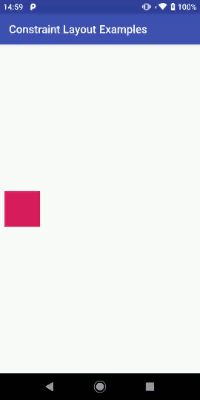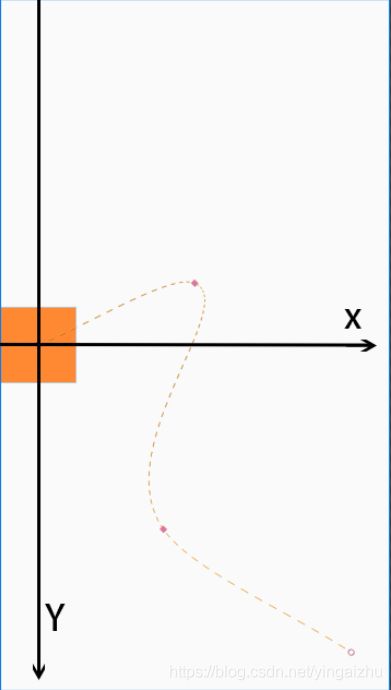Android MotionLayout详解
文章目录
- 一、前言
- 二、使用入门
- 2.1 引入依赖
- 2.2 创建 MotionLayout 布局文件
- 2.3 创建 MotionScene(运动描述文件)
- 2.4 在 MotionLayout 中配置运动描述
- 2.5 MotionLayout 的属性详解
- 三、运动描述文件详解
- 3.1 描述文件组成元素
- 3.2 元素详解
- 3.2.1
- 必须包含的元素
- 可以包含的元素
- 属性
- 3.2.2
- 语法
- 必须包含的元素
- 父元素
- 属性
- 3.2.3
- 语法
- 父元素
- 属性
- 3.2.4
- 语法
- 属性
- 可以包含的元素
- 父元素
- 3.2.5
- 语法
- 属性
- 3.2.6
- 语法
- 属性
- 父元素
- 3.2.7
- 语法
- 父元素
- 可以包含的元素
- 3.2.8
- 语法
- 属性
- 父元素
- 3.2.9
- 语法
- 属性
- 父元素
- 3.3 设置视图属性
- 3.3.1
插入标准属性 - 3.3.2
自定义属性 - 四、编后语
一、前言
MotionLayout 其实是一种布局类型,可帮助您管理动画。MotionLayout 是 ConstraintLayout的子类(关于 ConstraintLayout 的介绍可以参考: Android ConstraintLayout从入门到精通),因此, MotionLayout 拥有者 ConstraintLayout 同样强大的布局功能,它是 ConstraintLayout 库的一部分,可向后兼容 API 级别 14,也就是说,只需要引入 ConstraintLayout 的依赖,就可以使用 MotionLayout 了。
MotionLayout 将布局转换与复杂动画处理结合在一起,同时也在属性动画框架、TransitionManager 和 CoordinatorLayout 之间提供了各种功能。
除了描述布局之间的转换之外,MotionLayout 还能够为任何布局属性添加动画效果。此外,它本身就支持可搜索转换。也就是说,可以根据某个条件(例如触控输入)立即显示转换中的任意点。MotionLayout 还支持关键帧,从而实现完全自定义的转换以满足您的需求。
此外,MotionLayout 是完全声明性的,也就是说可以直接使用 XML 描述任何转换,无论复杂程度如何。
注意:
MotionLayout仅适用于为其直接子级添加动画,不支持嵌套布局层次结构或 Activity 转换。
二、使用入门
2.1 引入依赖
MotionLayout 是 ConstraintLayout 库的一部分,所以,只需要在程序模块的 build.gradle 文件中增加 ConstraintLayout 库的依赖就可以。
// support包引入,如果项目使用其他support包,使用这个
implementation 'com.android.support.constraint:constraint-layout:1.1.3'
// androidx包引入,如果项目使用androidx时使用,跟support包引入只能选其一,否则会冲突
implementation 'androidx.constraintlayout:constraintlayout:2.0.0-beta7'
2.2 创建 MotionLayout 布局文件
前面提到,MotionLayout 是 ConstraintLayout 的子类,所以,直接将布局中的 ConstraintLayout 类接替换成 MotionLayout 也是完全可以的。
<androidx.constraintlayout.motion.widget.MotionLayout xmlns:android="http://schemas.android.com/apk/res/android"
xmlns:app="http://schemas.android.com/apk/res-auto"
android:layout_width="match_parent"
android:layout_height="match_parent"
xmlns:tools="http://schemas.android.com/tools"
tools:showPaths="true">
<View
android:id="@+id/btn6"
android:layout_width="100dp"
android:layout_height="100dp"
android:background="@color/colorAccent"
android:text="Button6"/>
androidx.constraintlayout.motion.widget.MotionLayout>
2.3 创建 MotionScene(运动描述文件)
MotionLayout 是完全声明性的,使用 XML 文件描述任何转换,MotionLayout 的转换描述 XML 文件放在 res/xml 目录下,其中包含相应布局的所有运动描述。为了将布局信息与运动描述分开,每个 MotionLayout 都引用一个单独的 MotionScene。
注意:
MotionScene中的定义的运动描述优先于MotionLayout中的任何类似定义。
<MotionScene xmlns:android="http://schemas.android.com/apk/res/android"
xmlns:motion="http://schemas.android.com/apk/res-auto">
<Transition
motion:constraintSetStart="@+id/start"
motion:constraintSetEnd="@+id/end"
motion:duration="1000">
<OnSwipe
motion:touchAnchorId="@+id/btn6"
motion:touchAnchorSide="right"
motion:dragDirection="dragRight" />
Transition>
<ConstraintSet android:id="@+id/start">
<Constraint
android:id="@+id/btn6"
android:layout_width="64dp"
android:layout_height="64dp"
android:layout_marginStart="8dp"
motion:layout_constraintBottom_toBottomOf="parent"
motion:layout_constraintStart_toStartOf="parent"
motion:layout_constraintTop_toTopOf="parent"
motion:layout_constraintVertical_bias="0.5"
android:layout_marginLeft="8dp" >
<CustomAttribute
motion:attributeName="backgroundColor"
motion:customColorValue="#D81B60" />
Constraint>
ConstraintSet>
<ConstraintSet android:id="@+id/end">
<Constraint
android:id="@+id/btn6"
android:layout_width="64dp"
android:layout_height="64dp"
android:layout_marginEnd="8dp"
motion:layout_constraintBottom_toBottomOf="parent"
motion:layout_constraintEnd_toEndOf="parent"
motion:layout_constraintTop_toTopOf="parent" >
<CustomAttribute
motion:attributeName="backgroundColor"
motion:customColorValue="#FFFF00" />
Constraint>
ConstraintSet>
MotionScene>
提示:运动描述文件通过预定义的元素,声明运动的各种状态,关于描述文件的详细内容,请参考:运动描述文件详解
2.4 在 MotionLayout 中配置运动描述
创建运动描述文件之后,需要在布局文件中添加配置。添加运动描述配置,需要在 MotionLayout 跟节点上,通过 layoutDescription 属性配置。
<androidx.constraintlayout.motion.widget.MotionLayout xmlns:android="http://schemas.android.com/apk/res/android"
xmlns:app="http://schemas.android.com/apk/res-auto"
android:layout_width="match_parent"
android:layout_height="match_parent"
xmlns:tools="http://schemas.android.com/tools"
app:layoutDescription="@xml/scene_01"
tools:showPaths="true">
<View
android:id="@+id/btn6"
android:layout_width="100dp"
android:layout_height="100dp"
android:background="@color/colorAccent"
android:text="Button6"/>
androidx.constraintlayout.motion.widget.MotionLayout>
注意事项:运动描述文件和布局是一一对应的,一个
MotionLayout需要但对对应一个描述 XML 文件,并且描述文件中的所有控件的 ID 也必须在布局中能找到。
2.5 MotionLayout 的属性详解
MotionLayout 除了上述的 layoutDescription 属性以外,还有以下属性:
其他 MotionLayout 属性
除了上述示例中的属性之外,MotionLayout 还包含您可能想要指定的其他属性:
applyMotionScene:布尔类型,表示是否应用 MotionScene,默认值为 true。showPaths:布尔类型,表示在运动进行时是否显示运动路径。默认值为 false。progress:float类型,可以明确指定转换进度(取值0.0~1.0)currentState:reference类型,可指定具体的ConstraintSet。motionDebug:可显示与运动有关的其他调试信息。可取值有:SHOW_PROGRESS、SHOW_PATH或SHOW_ALL。
三、运动描述文件详解
3.1 描述文件组成元素
:描述文件的根节点元素。 :声明所有的视图控件在运动过程中,特定关键点的位置和属性。 :声明单个视图控件在运动过程中,特定关键点的位置和属性。 :声明运动过程中的开始和结束状态,包括所有预期的过度状态、用户的触发的交互等。 :声明当用户触摸特定的视图控件时所要执行的动作。 :声明当用户在布局中滑动时所要执行的动作。 :声明在运动过程中视图控件的位置和属性。 :声明在运动过程中特定时刻视图控件的位置。 :声明在运动过程中特定时刻视图控件的属性。
3.2 元素详解
3.2.1
- 语法
<MotionScene xmlns:android="http://schemas.android.com/apk/res/android"
xmlns:motion="http://schemas.android.com/apk/res-auto"
motion:defaultDuration="500">
MotionScene>
必须包含的元素
:指定运动场景需要的动画序列,可以有多个,每一个指定需要执行的运动序列。如果 MotionLayout会根据用户的互动选择最合适的
可以包含的元素
:运动的状态布局集,为 MotionLayout关联的
属性
defaultDuration:所有动画的默认持续时间(以毫秒为单位)。用于给未指定持续时间的
3.2.2
语法
...
ConstraintSet>
必须包含的元素
:必须包含一个或者多个
父元素
属性
android:id:集合的 ID,在deriveConstraintsFrom:(可选)值为另一个ConstraintSet的 ID。如果指定这个属性,ID 对应约束集合内的所有约束条件都将应用于此集合,除非此集明确替换它们。
- 示例:
<MotionScene xmlns:android="http://schemas.android.com/apk/res/android"
xmlns:motion="http://schemas.android.com/apk/res-auto"
motion:defaultDuration="500">
<Transition
motion:constraintSetStart="@+id/start"
motion:constraintSetEnd="@+id/end2"
motion:duration="1000">
<OnSwipe
motion:touchAnchorId="@+id/btn6"
motion:touchAnchorSide="right"
motion:dragDirection="dragRight" />
Transition>
<ConstraintSet android:id="@+id/start">
<Constraint
android:id="@+id/btn6"
android:layout_width="64dp"
android:layout_height="64dp"
android:layout_marginStart="8dp"
motion:layout_constraintBottom_toBottomOf="parent"
motion:layout_constraintStart_toStartOf="parent"
motion:layout_constraintTop_toTopOf="parent"
motion:layout_constraintHorizontal_bias="0.5"
android:layout_marginLeft="8dp" >
<CustomAttribute
motion:attributeName="backgroundColor"
motion:customColorValue="#D81B60" />
Constraint>
<Constraint
android:id="@+id/btn5"
android:layout_width="64dp"
android:layout_height="64dp"
android:layout_marginStart="8dp"
android:layout_marginBottom="8dp"
motion:layout_constraintBottom_toBottomOf="parent"
motion:layout_constraintStart_toStartOf="parent"
android:layout_marginLeft="8dp" >
<CustomAttribute
motion:attributeName="backgroundColor"
motion:customColorValue="#D8FF22" />
Constraint>
ConstraintSet>
<ConstraintSet android:id="@+id/end2"
motion:deriveConstraintsFrom="@+id/end">
ConstraintSet>
<ConstraintSet android:id="@+id/end">
<Constraint
android:id="@+id/btn6"
android:layout_width="64dp"
android:layout_height="64dp"
android:layout_marginEnd="8dp"
motion:layout_constraintBottom_toBottomOf="parent"
motion:layout_constraintEnd_toEndOf="parent"
motion:layout_constraintTop_toTopOf="parent" >
<CustomAttribute
motion:attributeName="backgroundColor"
motion:customColorValue="#FFFF00" />
Constraint>
<Constraint
android:id="@+id/btn5"
android:layout_width="64dp"
android:layout_height="64dp"
android:layout_marginEnd="8dp"
android:layout_marginTop="8dp"
motion:layout_constraintEnd_toEndOf="parent"
motion:layout_constraintTop_toTopOf="parent" >
<CustomAttribute
motion:attributeName="backgroundColor"
motion:customColorValue="#FF00FF" />
Constraint>
ConstraintSet>
MotionScene>
以上例子中,ID 为 end2 的
ConstraintSet包含了 ID 为 end 的ConstraintSet中所有的约束。如果在 end2 对同一个视图声明约束(Constraint),那么就会替换掉 end 中声明的对应约束。
3.2.3
语法
<Constraint
android:id="@+id/view_id_name"
attributes>
Constraint>
父元素
属性
android:id:视图 ID,约束视图的 ID ;- 其他在
ConstraintLayout中用来约束视图位置的属性;
3.2.4
该元素是用来声明运动过程中的开始和结束状态,包括所有预期的过度状态、用户的触发的交互等。
语法
...
[动画触发属性元素]
Transition>
属性
motion:constraintSetStart:运动序列的初始状态。可以是的 ID (属性值设置为“@+id/constraintSetId”),也可以是布局(属性值设置为"@layout/layoutName”)。 motion:constraintSetEnd:运动序列的最终状态。可以是的 ID (属性值设置为“@+id/constraintSetId”),也可以是布局(属性值设置为"@layout/layoutName”)。 motion:duration:运动序列的时长(单位:毫秒,可选)。如果未指定,则使用元素中的 defaultDuration属性值。
可以包含的元素
:表示运动序列是由用户轻触触发的。 :表示运动序列是由用户滑动触发的。 :用于为运动序列中的元素指定一个或多个中间位置或属性设置。
父元素
3.2.5
该元素用于指定当用户点按特定视图时要执行的操作,用于
说明:官方文档中说一个
元素内部可以有多个元素,但是笔者实践过程中发现不可行,会编译报错,不知道是否跟版本有关。
语法
<OnClick
motion:targetId="@+id/view_id"
motion:clickAction="actionName" />
属性
motion:targetId:点击的视图的 ID。motion:clickAction:点击时触发的操作,enum类型,可选值有:
| 取值 | 说明 | 备注 |
|---|---|---|
transitionToStart |
从当前状态转变到 motion::constraintSetStart 属性指定的状态,转变过程有动画效果 |
- |
transitionToEnd |
从当前状态转变到 motion:constraintSetEnd 属性指定的k状态,转变过程有动画效果。 |
- |
jumpToStart |
从当状态转变到 motion::constraintSetStart 属性指定的状态,转变过程无动画效果 |
- |
jumpToEnd |
从当状态转变到 motion:constraintSetEnd 属性指定的状态,转变过程无动画效果 |
- |
toggle |
在 motion::constraintSetStart 和 motion:constraintSetEnd 两个属性指定的两个状态中相互转换,转变过程有动画效果 |
只要在非这两个状态下,触发都会向目标状态的相反状态转变。例如:当动画执行到中间状态时,触发时,将不会到达当前动画的目标状态,而是立刻向当前动画的目标状态的相反状态转变 |
3.2.6
该元素用于指定当用户在不居中滑动时需要执行的操作。动画序列的速度和目标视图的动画,受滑动的速度和方向影响,滑动的速度和方向是通过可选参数配置来控制的。
说明:官方文档中说一个
元素内部可以有多个元素,但是笔者实践过程中发现不可行,会编译报错,不知道是否跟版本有关。
语法
<onSwipe
motion:touchAnchorId="@id/target_view"
motion:touchAnchorSide="side"
[ motion:dragDirection="direction" ]
[ motion:dragScale="scale" ]
[ motion:maxVelocity="maxVelocity" ]
[ motion:maxAcceleration="maxAcceleration" ]
[ motion:onTouchUp="action" ] />
属性
motion:touchAnchorId:滑动时需要移动的视图 ID。motion:touchAnchorSide:滑动所关联到的目标视图的锚点边,MotionLayout会尝试在该锚点点与用户手指之间保持恒定的距离。(可取值有:left、right、top和bottom)。motion:dragDirection:用户滑动的方向,如果设定了该值,这个dragLeft、dragRight、dragUp和dragDown)motion:dragScale:控制目标视图的滑动距离和用户手指滑动距离的相对比例,默认值是1。取值小于1时目标视图的移动速度小于手指滑动速度,取值大于1时目标视图的移动速度大于手指的滑动速度。motion:maxVelocity:目标视图的最大速度。motion:maxAcceleration:目标视图的最大加速度。motion:onTouchUp:触摸收起时的动作,可选值有:stop(停止动画)、autoComplete(自动完成动画)、autoCompleteToEnd(自动完成到结束状态)、autoCompleteToStart(自动完成到开始状态)、decelerate(减速停止动画)、decelerateAndComplete(减速并完成动画)、
父元素
3.2.7
前面提到,动画的声明是有 “开始状态” 和 “结束状态” 两个点,目标控件在这两个点之间移动,前面的例子都是直线的动画,显然这个实际使用中需要更复杂的动画。
语法
<KeyFrameSet>
[ <KeyPosition/>... ]
[ <KeyAttribute/>...]
KeyFrameSet>
父元素
可以包含的元素
3.2.8
该元素用于指定视图在运动过程中,在特定的时刻的位置。换句话说就是运动轨迹上的关键点的位置。在一个
语法
<KeyPosition
motion:motionTarget="@id/targetView"
motion:framePosition="frame position percentage"
motion:keyPositionType="position type"
motion:percentX="xOffset"
motion:percentY="yOffset"
/>
属性
motion:motionTarget:当前关键点位置控制的目标视图的 ID。motion:framePosition:关键帧位置,用百分比表示,取值为 0~100 之间的整数。(例如:取值20,表示该关键帧在运动轨迹的 20% 位置处 ),这个点将运动时间一分为二,两边的时间是相等的,如果运动轨迹长度不一样,那么将会造成运动速度不一样。但需要注意的是,关键帧的位置并不是关键点的位置。motion:keyPositionType:关键点的类型,不同的类型会对motion:percentX和motion:percentY的值做出不一样的解析。取值有parentRelative、deltaRelative和pathRelative。motion:percentX:X 轴方向的属性取值百分比,取值范围为0.0~1.0。motion:percentY:Y 轴方向的属性取值百分比,取值范围为0.0~1.0。
-
关键点类型详细说明
parentRelative:父容器关系型,即关键点的位置是相对于整个父容器中的相对位置来指定,percentX和percentY分别表示 X 轴和Y轴相对位置,取值为 -1.0~1.0(负数时目标视图将移动到父容器外面)。需要注意的是:关键点的位置是相对父容器来指定,跟 “开始点” 和 “结束点” 位置无关。deltaRelative:三角区域关系型,在目标视图整个运动序列移动的区域组成一个坐标轴,X 为横轴,Y 为纵轴,原点为 “开始点”,视图移动的方向为坐标的正方向。percentX和percentY分别为 X 轴和 Y 轴上的数值,控制关键点的位置,取值范围是 -1.0 ~ 1.0之间,负数表示在坐标轴的负值方向位置。framePosition一样控制的是轨迹弧顶的位置。pathRelative:路径关系型,即关键点的位置是相对于路径相对指定的,路径是指 “开始点” 和 “结束点” 的直线路径(构成 X 轴),percentX表示在 X 轴相对位置,0 表示在开始点, 1表示在结束点;percentY表示垂直于 X 轴(Y 轴)的相对位置,正数在 X 轴左侧,负数在 X 轴右侧。 |percentY取值范围为-1.0~1.0,Y 轴距离是以 “开始点” 和 “结束点”之间的距离为基数的百分比(也就是说 Y 轴的最大距离就是开始点和结束点直线距离的最大值,如果该值取0,弧度为0,则轨迹为直线)。另外,framePosition控制的是轨迹弧顶的位置(而不是关键点的位置),大于 50 时偏向起始点,小于50时偏向结束点,弧顶两端轨迹,运动时间是相等的,如果取了不对等的值(非50),就可以实现快慢变化的效果。
-
deltaRelative示例- 示例代码
<MotionScene xmlns:android="http://schemas.android.com/apk/res/android"
xmlns:motion="http://schemas.android.com/apk/res-auto"
motion:defaultDuration="2000">
<Transition
motion:constraintSetStart="@+id/btn7_start"
motion:constraintSetEnd="@+id/btn7_end">
<KeyFrameSet>
<KeyPosition
motion:motionTarget="@+id/btn7"
motion:framePosition="25"
motion:keyPositionType="deltaRelative"
motion:percentX="0.5"
motion:percentY="-0.2"/>
<KeyPosition
motion:motionTarget="@+id/btn7"
motion:framePosition="75"
motion:keyPositionType="deltaRelative"
motion:percentX="0.4"
motion:percentY="0.6"/>
KeyFrameSet>
Transition>
<ConstraintSet
android:id="@+id/btn7_start">
<Constraint
android:id="@+id/btn7"
android:layout_width="80dp"
android:layout_height="80dp"
motion:layout_constraintTop_toTopOf="parent"
motion:layout_constraintBottom_toBottomOf="parent"
motion:layout_constraintLeft_toLeftOf="parent"/>
ConstraintSet>
<ConstraintSet
android:id="@+id/btn7_end">
<Constraint
android:id="@+id/btn7"
android:layout_width="80dp"
android:layout_height="80dp"
motion:layout_constraintBottom_toBottomOf="parent"
motion:layout_constraintRight_toRightOf="parent" />
ConstraintSet>
MotionScene>
父元素
3.2.9
语法
属性
motion:motionTarget:设置属性的目标视图 IDmotion:framePosition:目标视图在序列中具有指定属性的帧位置,取值范围是 0 ~ 100 之间的整数(虽然是指定某个帧位置,但是动画会自动对属性的效果进行过度,而不是生硬的切换为该属性的效果)。- 可选的标准属性有:
android:alpha:视图的透明度android:elevation:视图的 Z 轴深度(在 API Level 21开始才有,像素单位,如dp)android:rotation:视图的旋转角度(默认方向)android:rotationX:视图 X 轴方向旋转角度android:rotationY:视图 Y 轴方向旋转角度android:scaleX:视图 X 轴方向缩放android:scaleY:视图 Y 轴方向缩放android:translationX:视图 X 轴方向的平移量(像素单位,如dp)android:translationY:视图 Y 轴方向的平移量(像素单位,如dp)android:translationZ:视图 Z 轴方向的平移量(在 API Level 21开始才有,像素单位,如dp)
说明:通过
元素可以设置关键点位置的标准属性,但是在开始位置和结束位置,可以设置视图的属性(包含标准属性和自定义属性),更多详情参考:设置视图属性
父元素
3.3 设置视图属性
前面提到可以通过在
3.3.1 插入标准属性
在
- 示例:
<MotionScene xmlns:android="http://schemas.android.com/apk/res/android"
xmlns:motion="http://schemas.android.com/apk/res-auto"
motion:defaultDuration="2000">
<Transition
motion:constraintSetStart="@+id/btn7_start"
motion:constraintSetEnd="@+id/btn7_end">
<OnSwipe
motion:touchAnchorId="@+id/btn7"
motion:touchAnchorSide="bottom"
motion:dragDirection="dragDown"
motion:maxVelocity="2"/>
<KeyFrameSet>
<KeyPosition
motion:motionTarget="@+id/btn7"
motion:framePosition="25"
motion:keyPositionType="deltaRelative"
motion:percentX="0.5"
motion:percentY="-0.2"/>
<KeyPosition
motion:motionTarget="@+id/btn7"
motion:framePosition="75"
motion:keyPositionType="deltaRelative"
motion:percentX="0.4"
motion:percentY="0.6"/>
KeyFrameSet>
Transition>
<ConstraintSet
android:id="@+id/btn7_start">
<Constraint
android:id="@+id/btn7"
android:layout_width="80dp"
android:layout_height="80dp"
motion:layout_constraintTop_toTopOf="parent"
motion:layout_constraintBottom_toBottomOf="parent"
motion:layout_constraintLeft_toLeftOf="parent"
android:rotation="45"
android:alpha="0.2">
Constraint>
ConstraintSet>
<ConstraintSet
android:id="@+id/btn7_end">
<Constraint
android:id="@+id/btn7"
android:layout_width="80dp"
android:layout_height="80dp"
motion:layout_constraintBottom_toBottomOf="parent"
motion:layout_constraintRight_toRightOf="parent"
android:rotation="145"
android:alpha="1.0">
Constraint>
ConstraintSet>
MotionScene>
-
效果
-
标准属性包括:
android:alpha:视图的透明度android:visibility:视图是否可见android:elevation:视图的 Z 轴深度(在 API Level 21开始才有,像素单位,如dp)android:rotation:视图的旋转角度(默认方向)android:rotationX:视图 X 轴方向旋转角度android:rotationY:视图 Y 轴方向旋转角度android:scaleX:视图 X 轴方向缩放android:scaleY:视图 Y 轴方向缩放android:translationX:视图 X 轴方向的平移量(像素单位,如dp)android:translationY:视图 Y 轴方向的平移量(像素单位,如dp)android:translationZ:视图 Z 轴方向的平移量(在 API Level 21开始才有,像素单位,如dp)
3.3.2 自定义属性
在 getter 和 setter 方法的,而且属性值的类型必须准确。
一个
motion:attributeName:属性名(必须)- 必须包含以下含类型的属性值的一个:
motion:customColorValue: 适用于颜色motion:customIntegerValue:适用于整数motion:customFloatValue:适用于浮点值motion:customStringValue:适用于字符串motion:customDimension:适用于尺寸motion:customBoolean:适用于布尔值
注意事项:
1. 属性名必须正确,且这个属性必须包含对外的getter和setter方法,否则自定义属性无效=;
2. 属性值必须选择正确的类型,否则自定义属性无效(可以查看setter方法中的参数类型选择正确的类型)。
- 示例:
<MotionScene xmlns:android="http://schemas.android.com/apk/res/android"
xmlns:motion="http://schemas.android.com/apk/res-auto"
motion:defaultDuration="2000">
<Transition
motion:constraintSetStart="@+id/btn7_start"
motion:constraintSetEnd="@+id/btn7_end">
<OnClick
motion:targetId="@+id/btn_start"
motion:clickAction="toggle" />
<KeyFrameSet>
<KeyPosition
motion:motionTarget="@+id/btn7"
motion:framePosition="25"
motion:keyPositionType="deltaRelative"
motion:percentX="0.5"
motion:percentY="-0.2"/>
<KeyPosition
motion:motionTarget="@+id/btn7"
motion:framePosition="75"
motion:keyPositionType="deltaRelative"
motion:percentX="0.4"
motion:percentY="0.6"/>
KeyFrameSet>
Transition>
<ConstraintSet
android:id="@+id/btn7_start">
<Constraint
android:id="@+id/btn7"
android:layout_width="80dp"
android:layout_height="80dp"
motion:layout_constraintTop_toTopOf="parent"
motion:layout_constraintBottom_toBottomOf="parent"
motion:layout_constraintLeft_toLeftOf="parent"
android:alpha="0.2">
<CustomAttribute
motion:attributeName="backgroundColor"
motion:customColorValue="@color/colorAccent" />
<CustomAttribute
motion:attributeName="rotation"
motion:customFloatValue="45.0" />
Constraint>
ConstraintSet>
<ConstraintSet
android:id="@+id/btn7_end">
<Constraint
android:id="@+id/btn7"
android:layout_width="80dp"
android:layout_height="80dp"
motion:layout_constraintBottom_toBottomOf="parent"
motion:layout_constraintRight_toRightOf="parent"
android:alpha="1.0">
<CustomAttribute
motion:attributeName="backgroundColor"
motion:customColorValue="@color/colorPrimary" />
<CustomAttribute
motion:attributeName="rotation"
motion:customFloatValue="145.0" />
Constraint>
ConstraintSet>
MotionScene>
- 实现效果
示例讲解:以上的示例中,使用
元素添加了两个自定义属性,分别是backgroundColor和rotation,这两个属性均有公开的getter和setter方法(setBackgroundColor()和setRotation()),所以自定义属性有效,其中backgroundColor是非标准属性,rotation是标准属性(可以直接在元素中设置)。
四、编后语
MotionLayout 在动画处理方面的能力非常强大,完全配置化,如果需要在布局中使用到动画的同学可以试试这个强大的布局。

